Illustrations for Nazariya’s document that attempts to present myths and facts about and around people with diverse gender identities and sexual orientations (LGBTIQA+). Not only does this document help demystify myths we tend to gather about LGBTIQA+ people and counter them with facts, it will also help readers reflect on the tendency to create myths about any practice that goes beyond what is considered normal. This list does not claim to be comprehensive. We hope you will build on this list and continue to reflect on beliefs, practices, and attitudes.
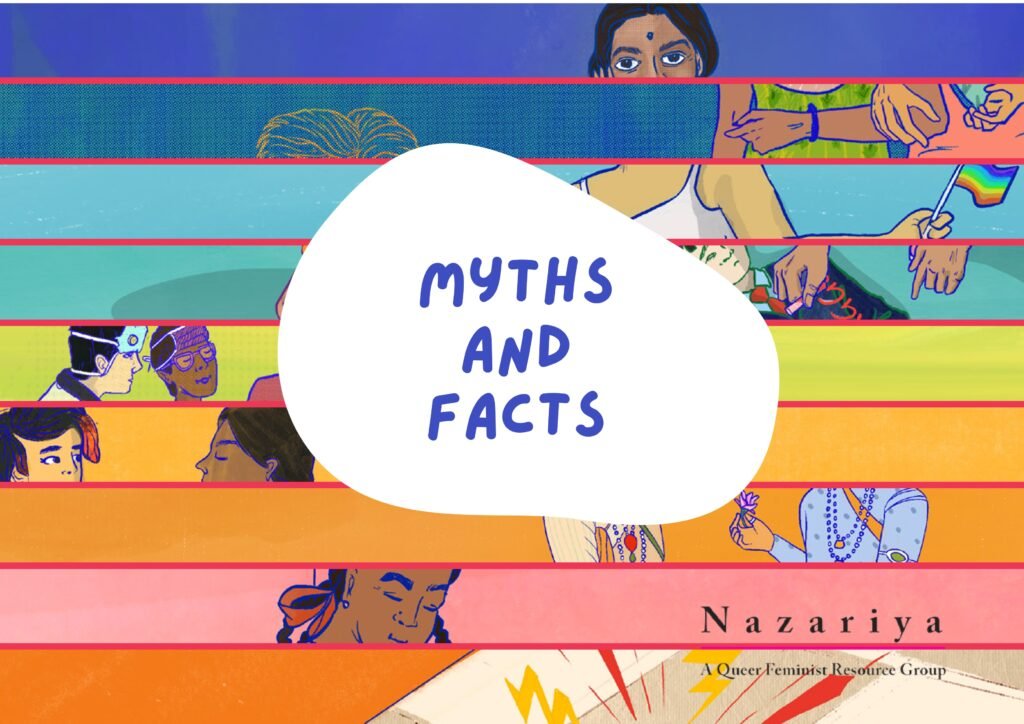
MYTH
It is unnatural/abnormal to be LGBT*QIA+.
FACT
Normal, natural are words that are very subjective; highly cultural, and change over time. This myth is pinned on the belief that all sexual relationships are formed for the procreation of children. The fact is that while there are heterosexual couples who decide to have children, there are many who do not choose to do so, and instead choose to engage in sexual activities that do not lead to procreation. There are also some couples who, for some reason, cannot have biological children.
Moreover, we need to question what we consider natural and unnatural. Are the cars we drive or the air conditioners we use natural? There is no fixed definition of normal. What one person considers perfectly normal might be found to be extremely abnormal in another city, culture, country, by a different group of people, or in a different era.
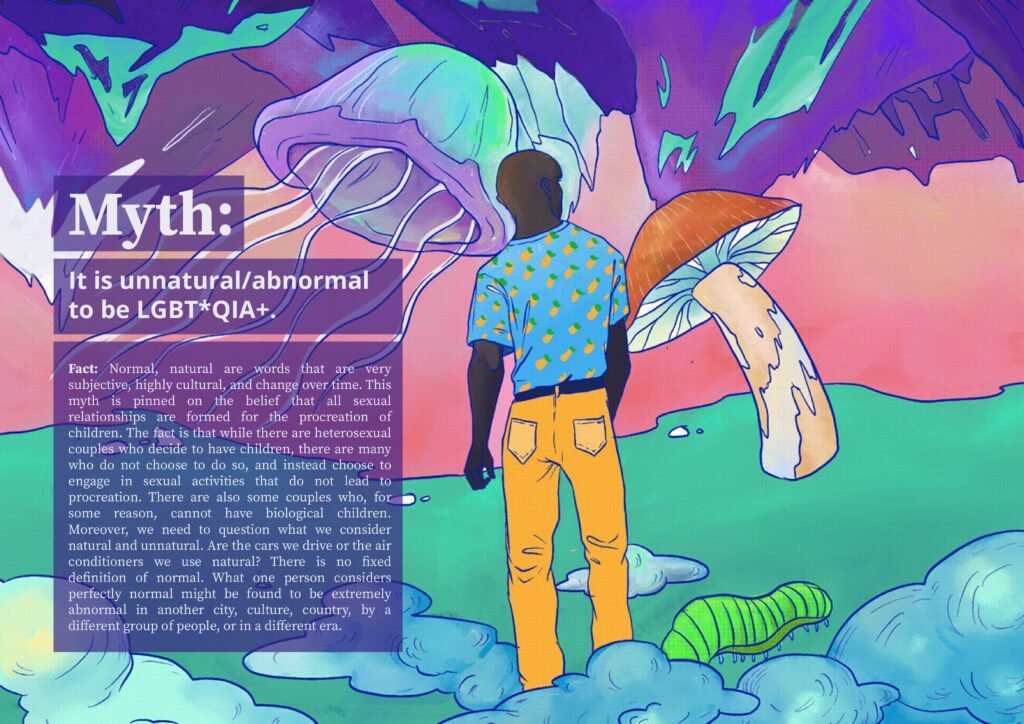
MYTH
Being LGBT*QIA+ is a mental condition and thus can be treated.
FACT
Although it was considered a mental illness once, The Diagnostic and Statistical Manual (DSM) of Mental Disorders brought out by the American Psychiatric Association (APA) removed homosexuality from its list of mental disorders and declared that homosexuality is as ‘healthy’ as heterosexuality. The World Health Organisation’s ICD-9 (International Statistical Classification of Diseases and Related Health Problems) had also listed homosexuality as a mental illness in 1977, but it was removed from the ICD-10, endorsed by the Forty-Third World Health Assembly in 1990. But even today certain individuals claim to cure queerness and many people from the LGBT*QIA+ community suffer because of this. However, many people with diverse gender identities and sexual orientationsv or whose behaviours that are not considered normal, can become maladjusted when they are treated with hostility.

MYTH
Men who act in a feminine manner must be gay. Masculine women with short haircuts and deep voices must be lesbians. Transmen are secretly lesbians, and transwomen are actually gay men.
FACT
This stereotypes confuse the concept of sexual orientation (whether you prefer the same or another sex as sexual partners) with gender roles (exhibiting masculine or feminine behaviour). There are many homosexual men who are masculine, and many homosexual women who are feminine. Besides, some heterosexual men have feminine traits, and some heterosexual women have masculine traits. Transmen are people who were assigned female at birth but their gender identity and expression is that of men. They prefer to be addressed as men, and this is because they are men. As for their sexual orientation, they may like women or they may like men. Similarly, transwomen are people who were assigned male at birth but their gender identity and expression is that of women. They prefer to be addressed as women because they are women. And they may be attracted to men or women.
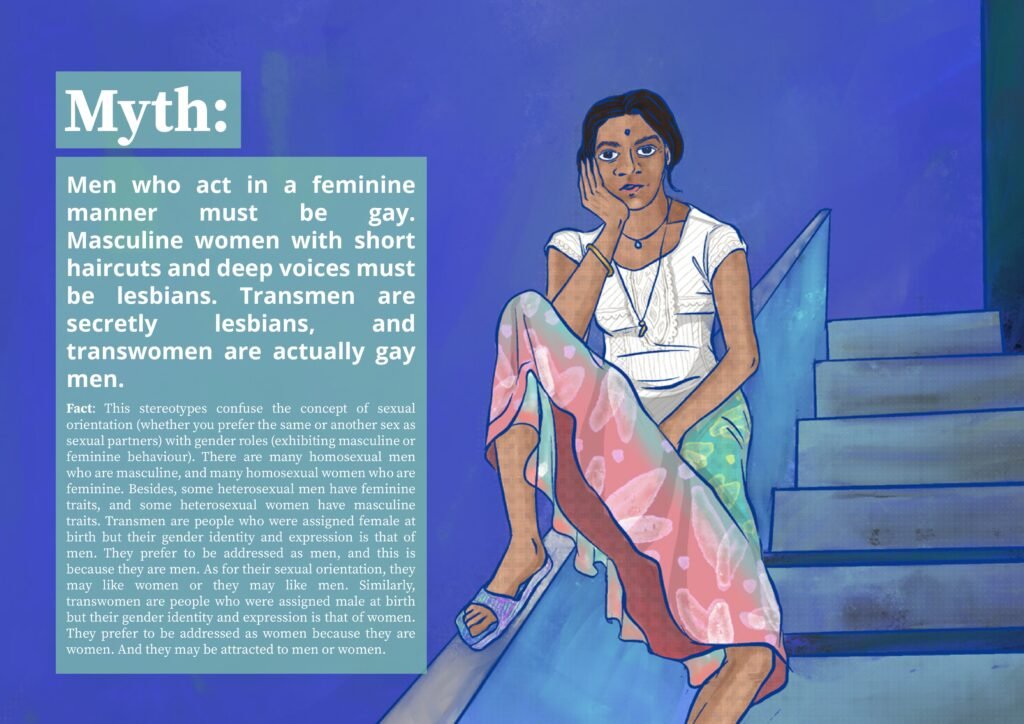
MYTH
Bisexual people have multiple partners.
FACT
By definition, bisexual individuals have romantic and/or sexual feelings towards persons of another gender as well as towards persons of the same gender as them. This does not automatically imply involvement with more than one partner at a time any more than a heterosexual person’s ability to be attracted to more than one person automatically implies multiple partners.

MYTH
Same-sex relationships/ marriages will lead to polygamy, pedophilia, people wanting to marry their dogs and subsequently the end of the world.
FACT
There is no such proof of the above statement. Homosexual relationships/ marriages are no more likely to lead to such issues than heterosexual relationships/ marriages. There is no logical link between same-sex relationships/ marriage and pedophilia or polygamy. A relationship or marriage people should be an association between consenting people (and not forced). Same sex is about consent, polygamy is about
consent. Pedophilia, bestiality are not about consent.

MYTH
Being with LGBT*QIA+ individuals would turn me into one
FACT
Since it is not a disease, it cannot be passed on. If people come to queer individuals and make friends, they may just feel a genuine connection and not because they have been converted. When friends or someone who trusts you ‘comes out’ (reveals their sexual orientation, or gender identity) to you, they are essentially inviting you to know them better. If an LGBT*QIA+ person chooses to come out to you, that person has decided to share a part of their identity with you. Such a disclosure only means that this friend trusts you. Liking or loving someone is not contagious.

MYTH
Early sexual experiences are indicative of one’s sexual orientation as an adult, and LGBT*QIA+ people are abused in their childhood.
FACT
Many lesbian, gay, and bisexual people in pursuit of their sexual orientation may have heterosexual experiences, similar to many heterosexual people who may have homosexual experiences. Sexual activity per se does not make you lesbian, bisexual, or gay. Feeling comfortable with and identifying with that sexual activity, identity, or orientation may determine it.
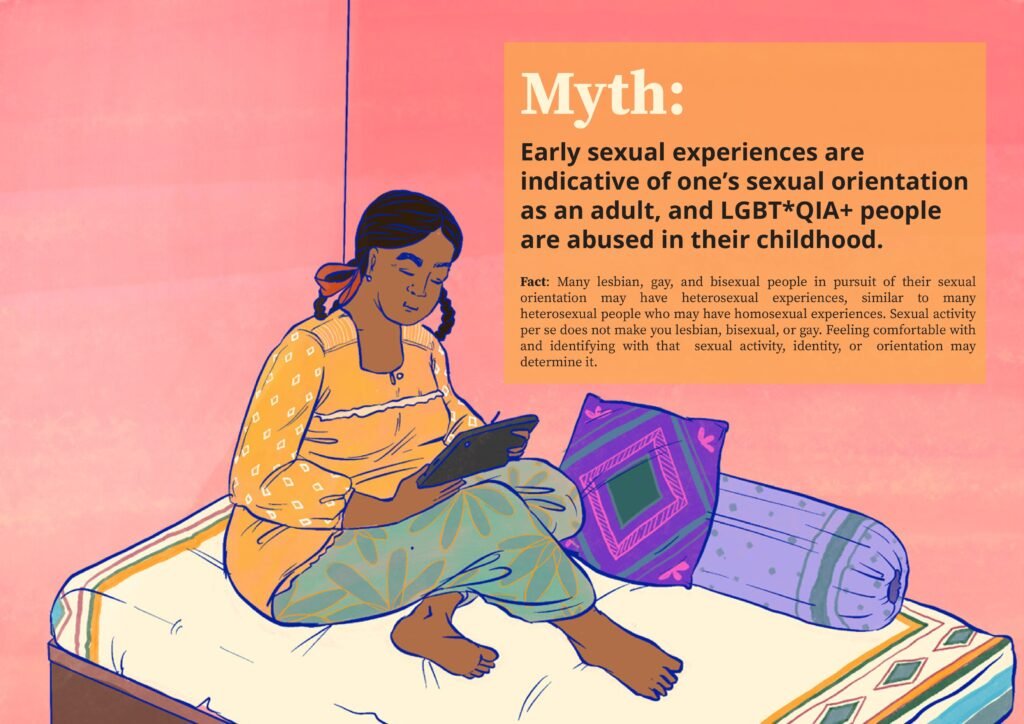
MYTH
It is very easy to spot LGBT people. They flaunt their sexuality when they talk about their partner, hold hands, or kiss one another in public (especially gay men). You can always tell homosexuals by the way they look or act.
FACT
Human beings come in all shapes and sizes and have diverse preferences. There is no easy way to determine who likes whom or what. For instance, we can find out about someone’s food preferences or taste in films only by their choosing to share that information. Similarly, there is no accurate way to find out someone’s sexual orientation or sexual desires except for when they share with us about it. However, because of homophobia not many lesbian, bisexual, or gay people come out about their sexual orientations in the open. Besides some who are not LGBTQIA+ might also choose to look or act in ways that are not considered normal.
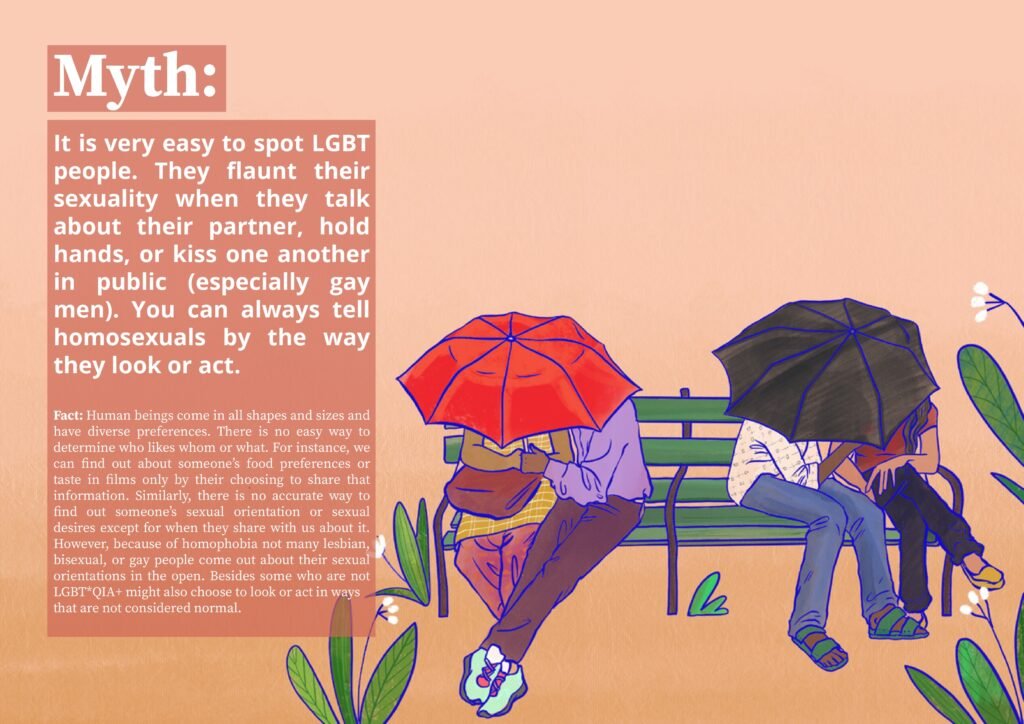
MYTH
We know what causes homosexuality and transgender identity, and working on that can reverse these.
FACT
Many LGBT*QIA+ people may know that they are attracted to members of their own gender, or that they identify as another gender, at an early age. Sometimes they may know when they are older, or when they are much, much older and well into their lives. There is no appropriate/right age to start identifying as LGBTQIA+. There are various studies, research, and opinions to determine what causes someone to be homosexual or identify as a gender other than what they were assigned at birth but these are all possibilities. There is no definitive theory or text that can tell us what causes particular orientations or makes your gender identity.
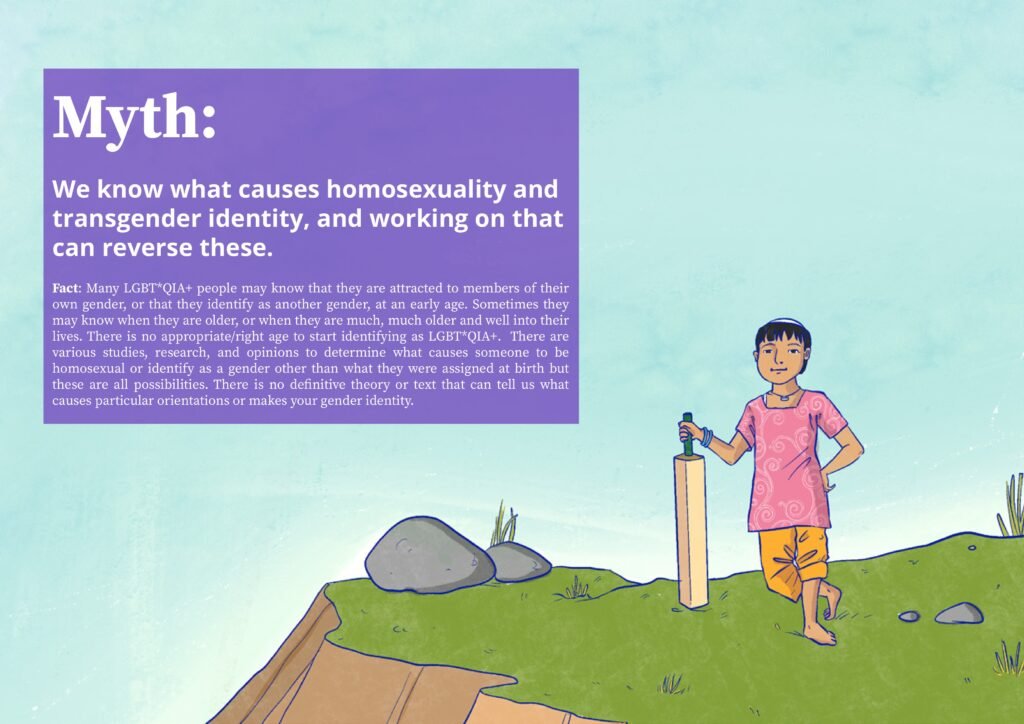
MYTH
Gay men hate women and lesbian women hate men.
FACT
Gay men and lesbians, like heterosexual people, have friends and acquaintances who vary in gender identity and sexual orientation. Like anyone else, lesbian and gay people have personal preferences concerning those individuals they like to be around and choose as friends, and most people prefer being together in groups and communities with others who share their own values and identities. Preferring to have certain types of people as friends, or to have a romantic attraction to a particular type of person does not mean that one hates or dislikes those who are outside that circle. In other words, if you really like rice, it does not mean that you dislike or hate chapatis!

MYTH
LGBT culture is a non-Indian, western concept, and we must oppose it.
FACT
There are several instances of sexual relationships mentioned in Indian culture – be it in old architecture or in literature. For instance, there are mentions of same-sex relationships in the Kama Sutra and in architecture of Khajuraho. One may choose different things from different cultures, not everything everywhere is all good. Here we should also note that Indian law is Western; i.e. the British introduced Section 377 (and related laws deeming homosexuality an unnatural and punishable offence) in penal codes of their colonies such as India, Pakistan, and Sri Lanka in 1860.

MYTH
In a same-sex relationship, one partner usually plays the masculine role & the other one plays the feminine role.
FACT
Within the heterosexual community, there are all types of relationships, and people perform all kinds of domestic/romantic/sexual roles. This is true for same-sex relationships as well. Some people, both heterosexual and homosexual, perform roles that are commonly associated with their gender identity, and it could take precedence over what they may actually prefer doing. There are, however, many couples and people of all sexual orientations and gender identities who believe that people should have the freedom to live roles or do things they like doing rather than what is associated with their gender identity. Also to keep in mind that these gender roles are socially constructed and everything is built around ‘normative’ ideals.

MYTH
LGBTQIA+ persons are promiscuous.
FACT
Same-sex desiring persons or those who deviate from sexual and gender norms are neither more nor less sexually promiscuous (engaging with multiple partners) than those who do not. Like heterosexual people, many LGBTQIA+ people are involved in monogamous relationships and are committed to each other. Some LGBTQIA+ people may also choose to remain celibate or might be asexual, and others may have multiple partners. This is similar to heterosexual people whose sexual life and preferences we cannot know about till they tell us.
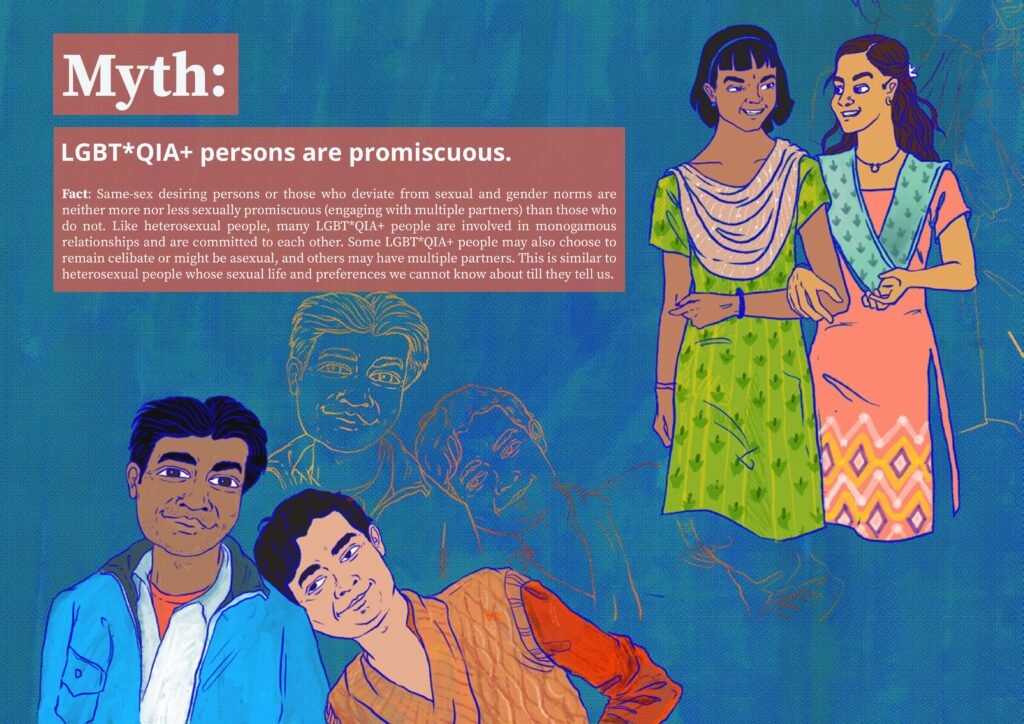
Download the PDF here